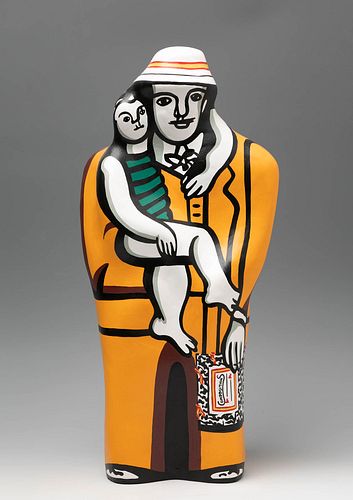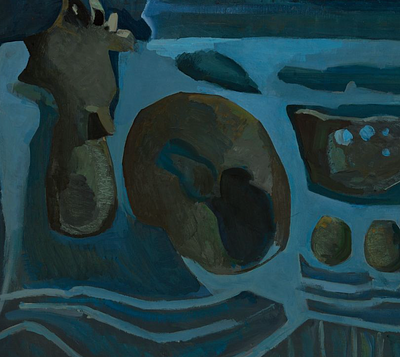CRONICA TEAM (Valencia, 1964 - 1981). "San Cristobal", 1971. Painting on papier-mâché. Copy 31/75. Signed and numbered.
Lot 82
About Seller
Setdart Auction House
Carrer Aragó 346
Barcelona
Spain
Setdart Subastas was born in 2004 and is currently the first online art auction in Spain with solidity, prestige and reliability guaranteed by our more than 60,000 users. Setdart has a young, dynamic and enterprising team ready to successfully manage the purchase and sale of art works through custom...Read more
Estimate:
EUR€6,000 - EUR€8,000
$6,382.98 - $8,510.64
Absentee vs Live bid
Two ways to bid:
- Leave a max absentee bid and the platform will bid on your behalf up to your maximum bid during the live auction.
- Bid live during the auction and your bids will be submitted real-time to the auctioneer.
Bid Increments
| Price | Bid Increment |
|---|---|
| EUR€0 | EUR€10 |
| EUR€200 | EUR€25 |
| EUR€500 | EUR€50 |
| EUR€1,000 | EUR€100 |
| EUR€3,000 | EUR€200 |
| EUR€5,000 | EUR€500 |
| EUR€10,000 | EUR€1,000 |
| EUR€20,000 | EUR€2,000 |
| EUR€50,000 | EUR€5,000 |
About Auction
By Setdart Auction House
Jul 27, 2021
Set Reminder
2021-07-27 08:00:00
2021-07-27 08:00:00
America/New_York
Bidsquare
Bidsquare : CONTEMPORARY AND ACTUAL ART
https://www.bidsquare.com/auctions/setdart-auction-house/contemporary-and-actual-art-7261
Setdart Auction House sofia@setdart.com
Setdart Auction House sofia@setdart.com
- Lot Description
CRONICA TEAM (Valencia, 1964 - 1981). "San Cristobal", 1971. Painting on papier-mâché. Copy 31/75. Signed and numbered. Publisher: Gustavo Gili, Barcelona. Workshop: Vicente Luna, Valencia Size: 53 x 25 x 14 cm. Equipo Crónica proposes in its San Cristóbal a renewal of the Saint and his iconography. From its characteristic style, Equipo Crónica shows us a character holding a child in his hands, just as Saint Christopher holds the figure of Christ. The origin of the iconography of St. Christopher dates back to the 11th century. His name comes from the word Christophorus, which in Greek means "the one who carries Christ". Originally, this expression was understood in a spiritual sense, as the one who carries Christ in his heart. Later it was taken in a material sense. Equipo Crónica, or Crónicas de la Realidad, was a group of Spanish painters active between 1964 and 1981. It was founded by Manolo Valdés, Juan Antonio Toledo, who soon left the group, and Rafael Solbes, whose death in 1981 put an end to the project. The historian and critic Tomás Llorens was also a member of the group. He explains the theoretical basis of the Equipo in a text entitled "La distanciación de la Distanciación" (The Distancing of Distanciation). Likewise, the three painters signed a manifesto in 1965, where they defined themselves as a working group with collective methods and supra-individual goals. Equipo Crónica moved away from the prevailing informalism to cultivate a figurative painting, closely linked to pop-art. Fed up with introspection, these artists went out into the street and observed the world around them, a society of incipient industrialization and tourists. Their themes critically analyzed the political situation in Spain, as well as the History of Art, for which they were inspired by classic works such as Picasso's "Guernica" or Velázquez's "Las Meninas". Their style was a unique blend of realism, criticism, pop, pictorial quotations, anachronisms and bittersweet pastiches. In contrast to the grandiose and picturesque image of Spain that Franco's regime wanted to project abroad, Equipo Crónica focused on another, darker and more somber image of the country, always resorting to irony. Starting from their own direct style, with clear images that everyone could read, they tried to make a "chronicle of reality", a sort of social realism but using current visual systems. The group produced paintings, sculptures and engravings, and used to work in series, which allowed them to analyze the same subject with different variations. Equipo Crónica starts from a very simple language, with monochrome and repeated images, very close to contemporary media, especially newspaper photographs. From there, after the turning point of "Latin Lover" in 1966, the members of the group gradually enriched their language to put it at the service of political satire. Demystifying and decontextualizing the works of classic Spanish masters such as Velázquez, Goya or El Greco, they made their figures appear (the gentleman with his hand on his chest, the Duchess of Alba, etc.) as images in newspapers or advertisements, inaugurating buildings or among washing machines and express pots. There are works by Equipo Crónica in the IVAM in Valencia, the Reina Sofía Museum in Madrid, the MACBA in Barcelona, the Juan March Foundation and the Patio Herreriano Museum in Valladolid, among others. In 2007 an exhibition dedicated to Equipo Crónica was organized at the Museo de Arte Abstracto in Cuenca.
- Shipping Info
-
In-house shipping available. Please inquire at admin@setdart.com.
-
- Buyer's Premium



 EUR
EUR CAD
CAD AUD
AUD GBP
GBP MXN
MXN HKD
HKD CNY
CNY MYR
MYR SEK
SEK SGD
SGD CHF
CHF THB
THB
















